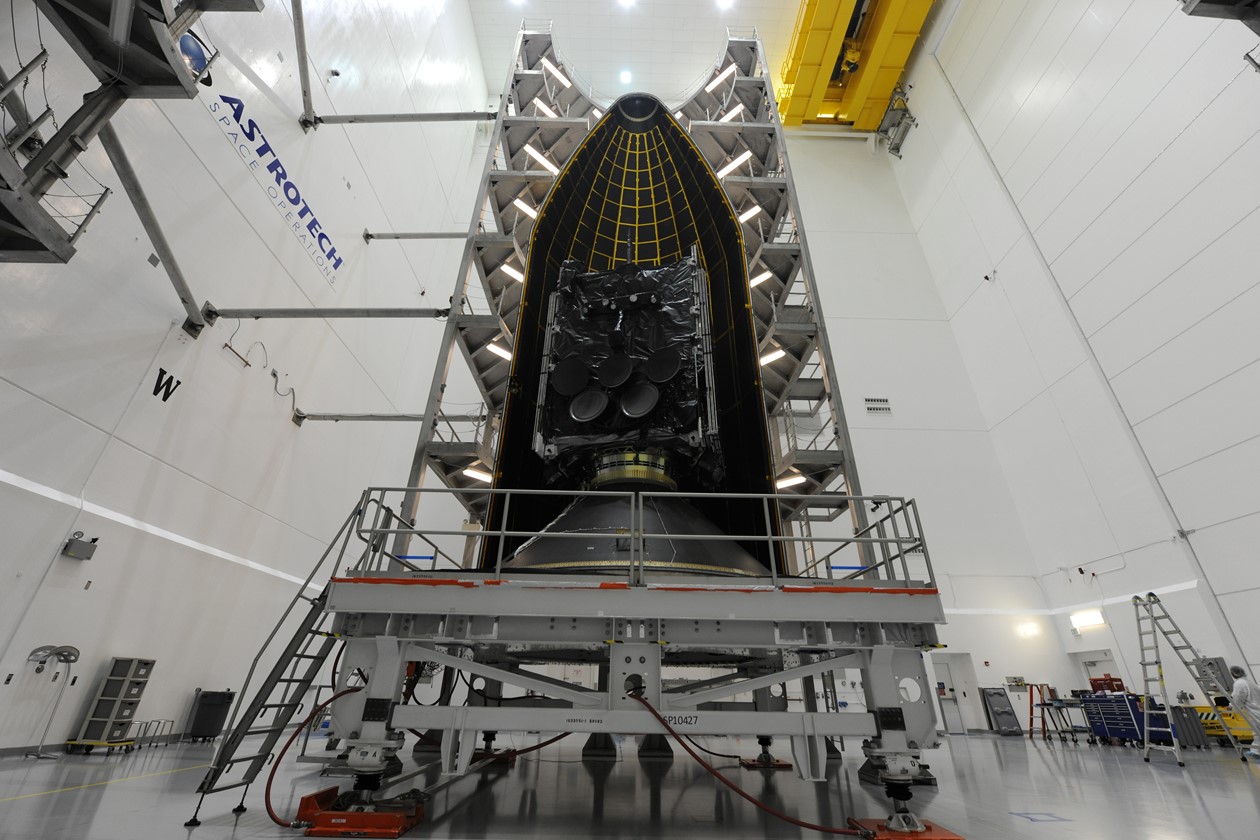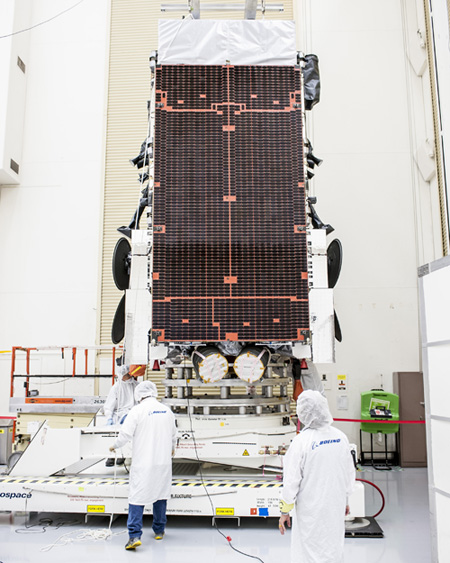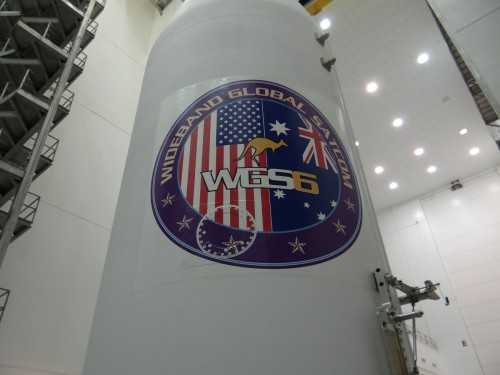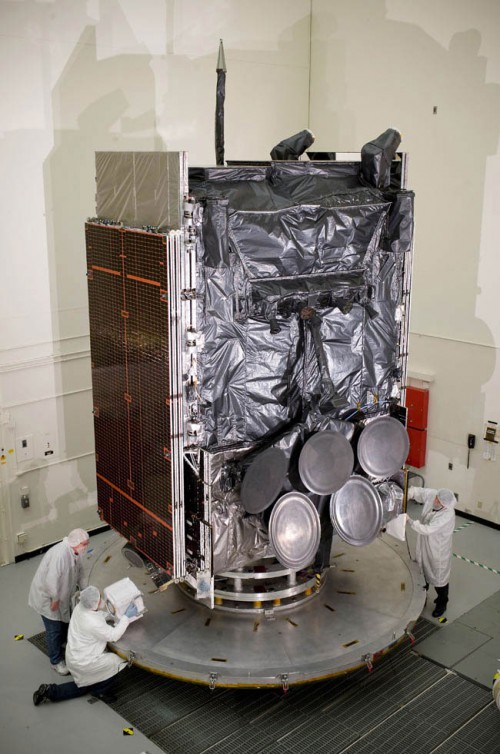
Boeing and the U.S. Space Force have successfully completed the first major engineering design review of the next Wideband Global Satcom, identified as “WGS-11+” and scheduled for launch later this decade. According to the Space and Missile Systems Center (SMC) at Los Angeles Air Force Base, Calif., it was the program’s first-ever, all-virtual Preliminary Design Review (PDR). Completion of this major milestone allows WGS-11+ to enter full-scale production next year, with delivery targeted for March 2024.
Building on the heritage of ten previous WGS missions, all launched by United Launch Alliance (ULA)—the first two atop Atlas Vs in October 2007 and April 2009, followed by the remainder aboard the Delta IV Medium+ between December 2009 and March of last year—this all-new military communications satellite will feature a modern digital payload with double the operational capability of its predecessors.
Narrower “spot-beams” will deliver communications power to exactly where it is needed, thereby enhancing the resilience and performance of these powerful satellites in Geosynchronous Earth Orbit (GEO), about 22,600 miles (35,900 km) above the Home Planet.

“Completing this engineering design review is a key milestone and brings us one step closer to delivering this groundbreaking satellite to the warfighter in record time, significantly improving capacity and coverage to our soldiers, sailors, airmen, Marines and allies,” said Col. John Dukes, chief of the Geosynchronous/Polar Division at Space and Missile Systems Center Production Corps.
“WGS-11+ uses narrower spot-beams to deliver a stronger, more reliable connection exactly where it’s needed,” added Troy Dawson, vice president of Boeing Government Satellite Systems, “which means better performance and greater flexibility than ever before.”
The original “Block 1” members of the WGS fleet, numbered WGS-1, 2 and 3, were launched between October 2007 and December 2009 to provide complete strategic coverage of the Pacific and Atlantic Oceans and support U.S. Central Command in Afghanistan, Iraq and western Asia.
This was followed by the “Block 2” fleet of WGS-4, 5 and 6, launched between January 2012 and August 2013, by which time Boeing was already working on a $182 million contract to develop four “follow-on” satellites, the first of which (WGS-7) rose safely into orbit in July 2015.

Two more Block 2 follow-ons were launched in December 2016 and March 2017, with WGS-10 closing out the ten-strong network in March of last year. The fleet is operated by the Space and Missile Systems Center (SMC) at Los Angeles Air Force Base, Calif.
Each satellite is based on Boeing’s BSS-702 “bus”, with a reported mass of around 13,200 pounds (6,000 kg) and the capability to provide more than 11 kilowatts of electrical power at the end of its 14-year operational lifetime. The WGS network has evolved considerably through its three phases, with enhanced levels of instantaneous switchable bandwidth and broader capacity for tactical users, as well as switchable radio frequency bypass functionality to support the transmission of ultra-high bandwidth airborne intelligence, surveillance and reconnaissance imagery via unmanned aerial vehicles.
Whereas the Block 1 and Block 2 satellites could instantaneously filter and downlink up to 4.410 GHz, their Block 2 follow-on variants can achieve up to 8.088 GHz. When WGS-10 was ordered by the Air Force in July 2012, Boeing received contracts to incorporate wideband digital channelizers aboard WGS-8, WGS-9 and WGS-10 to afford a 90-percent improvement in bandwidth.
The WGS design includes 19 independent coverage areas to serve U.S. and allied warfighters operating between 65 degrees North and South latitudes, with eight steerable X-band beams, ten steerable Ka-band beams and a single X-band Earth-coverage beam. Depending upon the mix of ground terminals, data rates and modulation and coding schemes utilized, a single WGS can support over 6 Gbps and—for the more recent satellites, with advanced digital channelizers—can handle over 11 Gbps.

In 2018, it was reported that Congress had provided $600 million in additional funding for two more satellites, whose development was expected to “move faster” than earlier WGS missions “on a commercial timeline”. According to Rico Attanasio, Boeing’s director of Department of Defense and civil navigation and communications programs, quoted by Space News, advantage would be taken of new commercial satellite buses and improved manufacturing techniques, alongside building upon previous success. Just last December, Boeing reported that WGS-11 and 12 will benefit from “a new variant” of its BSS-702 bus (known as the “702X”), with greater bandwidth and signal strength.
In particular, SMC is utilizing Model-Based Systems Engineering (MBSE) as part of concerted efforts to put WGS-11+ on an “aggressive schedule”. Contracts between SMC and Boeing were definitized on 10 February 2020, with construction expected to commence at Boeing’s facility in El Segundo, Calif., next year. The complete satellite is due to be delivered in March 2024. A launch provider has yet to be determined, although a ULA Vulcan-Centaur or a SpaceX Falcon 9 appear the likely front-runners.

The MBSE philosophy encourages systems engineering best practices through the use of digital modeling to describe requirements, analysis, design and verification of systems or architectures. It also more efficiently prototypes and explores system behavior at a very low cost, compared to traditional, paper-based engineering approaches.
“WGS-11+ is utilizing a collaborative MBSE environment tool to drive end-to-end and payload systems engineering decisions on the road to Preliminary Design Review,” Boeing noted in a March 2020 news release. “The digital engineering tool allows teams to holistically evaluate designs and requirements across the modeled system and quickly identify impacts.”
.
.
FOLLOW AmericaSpace on Facebook and Twitter!
.
.





